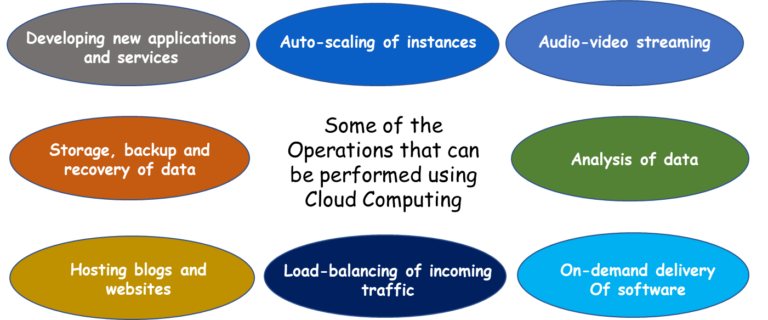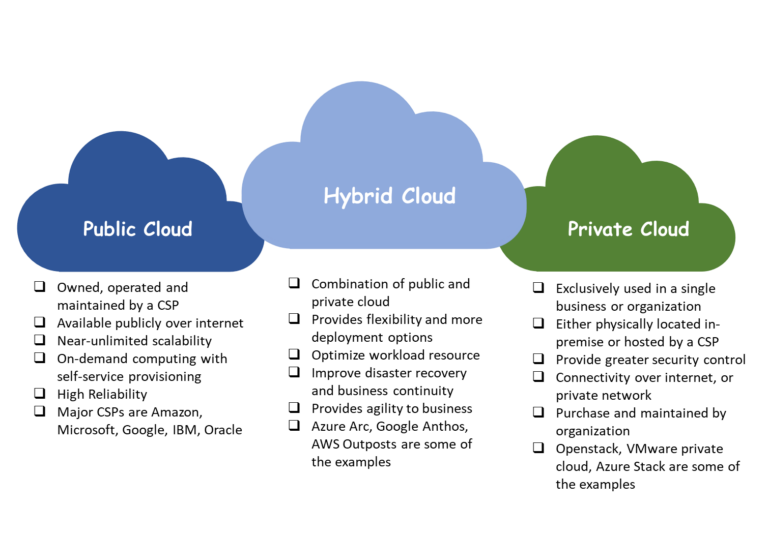Cloud Computing
Cloud Overview
If you are in IT space then you would’ve definitely heard about Cloud Computing. It’s all over the place, and everyone appears to be talking about it because it has helped the organizations magically, simplifying numerous processes that were previously impossible.
In this blog, you will learn:
- Cloud Computing
- Cloud Computing Architecture
- Cloud Service Models
- Cloud Deployment Models
- Features of Cloud Computing
- Advantages of Cloud Computing
- Disadvantages of Cloud Computing
- Top 3 Cloud Service Provider
What is Cloud Computing?
Cloud computing is an on-demand delivery of computing services that allows us to create, configure, and customize applications over the internet. This includes different development platforms, storage, software applications, networking, databases, etc.

Cloud Computing Architecture
 Small and large businesses use cloud computing technology to store data on the cloud and access it from anywhere at any time via an internet connection. The architecture of cloud computing is a mixture of service-oriented and event-driven architecture.
Small and large businesses use cloud computing technology to store data on the cloud and access it from anywhere at any time via an internet connection. The architecture of cloud computing is a mixture of service-oriented and event-driven architecture.
It has mainly two parts,
Front End: It is used by the client. It includes client-side interfaces and applications for interacting with cloud computing services. Web servers, thin and thick clients, tablets, and mobile devices are all part of the front end.
Back End: It is used by the service provider. It oversees all of the resources needed to deliver cloud computing services. It includes a variety of components such as data storage, security methods, virtual machines, deployment models, servers, and traffic control mechanisms. The back end ensures that the cloud resources are provisioned, maintained, and scaled according to the users’ needs.
Cloud Service Models
- Infrastructure as a Service (IaaS)
This service provides infrastructure on cloud allowing organizations to host and manage their computing resources like servers, storage, networking, databases etc. In this way, it is actually helping organizations to use the resources without investing in physical hardware.
- Platform as a Service (PaaS)
In this model, the cloud vendor provides an on-demand platform for developing, testing, delivering, and managing software applications. The developer is responsible for the application, while the cloud vendor provides the ability to deploy and run it on their infrastructure.
- Software as a Service (SaaS)
It is a cloud-based software delivery model which delivers software to the end users over the internet, on-demand, and on a subscription basis. SaaS is used to minimize the operational cost to the maximum extent.
gCloud Deployment Models

Features of Cloud Computing
Cloud computing is getting highly prevalent. Continuously expanding and growing business necessitates massive processing power and large-scale data storage systems. Cloud computing allows businesses to grow and safely shift data from physical places to the ‘cloud,’ which can be accessed from anywhere. Cloud computing has a number of features that make it one of the most swiftly growing industry today. Cloud services’ versatility, in the form of a growing collection of tools and technologies, has encouraged their adoption across industries.

Advantages of Cloud Computing
- Cost Savings: It has eliminated the capital cost of buying physical hardware.
- Pay-per-use model: Cloud computing has enabled its users to pay as per the usage of services.
- Better Collaboration: It has enabled the group of people to quickly share the information via different cloud applications.
- Mobility: It has enabled the access of organizations data securely via smart phones and devices.
- Scalability: Depending on the business needs, we can increase or decrease the resources as required.
- High Speed: With cloud computing, we may instantly deploy the computing services with fewer clicks and in less time.
- Productivity: We spend less time on operations when we use cloud computing. Patching and maintaining hardware and software are not required. As a result, the IT department will be more productive and focused on meeting business objectives.
- Reliability: For business continuity, data backup and recovery has been less expensive and quick.
- Data security: One of the most significant advantages of cloud computing is data security. The cloud has several advanced security mechanisms that ensure data is stored and handled safely.
Disadvantages of Cloud Computing
- Internet Connectivity – It is the basic and essential need to use cloud computing services. Hence, if there is no good internet connectivity, we won’t be able to use the services properly.
- Interoperability – The most significant downside of cloud computing is interoperability. When switching services from one service provider to another, organizations may run into issues. Because different providers offer different platforms, switching from one cloud to another might be complicated.
- Limited Control – Because cloud infrastructure is owned, controlled, and monitored entirely by the service provider, cloud customers have less influence over the function and execution of services within it.
- Security – Although cloud service companies adhere to the highest security standards when storing sensitive data. However, you should be aware that by using cloud technology, you will be transmitting all of your company’s sensitive data to a third party, namely a cloud computing service provider. While sending data to the cloud, there is a possibility that hackers will gain access to your company’s information.
Top 3 Cloud Service Provider
- Amazon Web Services (AWS)
AWS was first introduced in 2002. With millions of active customers and thousands of partners worldwide, AWS is an established market leader with largest community. Most businesses utilize AWS to grow their operations by transferring their IT administration to the cloud. AWS offers flexibility, security, scalability, and improved performance, among other benefits.
- Microsoft Azure
Microsoft Azure was introduced in 2010. It is a global cloud platform that is used to develop, launch, and manage the computing services. It is very open to hybrid cloud systems and supports multiple programming languages such as Java, Nodejs, C, and C#. It can be easily integrated with other Microsoft systems and services.
- Google Cloud Platform (GCP)
GCP was introduced by Google in 2011. Most businesses utilize this platform to quickly design, transfer, and deploy cloud apps. It is specialized in high compute offerings like Data Analytics, Data Storage, Machine Learning, and supports various databases such as SQL, MYSQL, Oracle, Sam, and much more. It provides APIs for its services and has a good reputation in open-source community.
To test your fundamentals skills on cloud computing you can visit us at